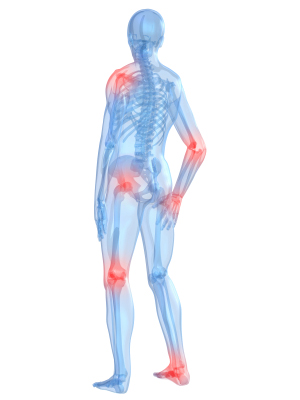Joint Bleeds
 Joint bleeds are bleeding that occurs in the space where two bones meet. They happen most often in the elbows, knees, and ankles. Joints in the shoulders, wrists, fingers, hips, and toes can bleed also. When the joint fills up with blood, the pressure causes pain. If the bleed is not treated, the joint can be permanently damaged.
Joint bleeds are bleeding that occurs in the space where two bones meet. They happen most often in the elbows, knees, and ankles. Joints in the shoulders, wrists, fingers, hips, and toes can bleed also. When the joint fills up with blood, the pressure causes pain. If the bleed is not treated, the joint can be permanently damaged.
Bleeding into a joint is common with Hemophilia. It is not as common with VWD and platelet disorders. People with Type 2N and especially those with Type 3 VWD are more likely to bleed into their joints. This is because they have low levels of factor VIII as well as VWF. People with other types of VWD may have joint bleeding if they have an injury to the joint.
Early signs that you are having a joint bleed:
- You get a hard hit to the joint.
- You have an "aura". An aura is a special, hard-to-explain feeling that some people with hemophilia get when they start to have a bleed.
- There is a bubbling or tingling feeling in the joint.
- The joint feels warm inside.
- A baby with a bleeding disorder who is cranky or crying for no reason you can see (not because of hunger, thirst, a need to be held, stomachache, wet diaper, or cold), may be bleeding inside a joint. You may also notice they are not using a certain part of their body or not as active if they are having a joint bleed.
Later signs that there is bleeding in a joint:
Try to treat before these happen!
- The skin over the joint feels warmer than other nearby skin.
- The joint is stiff.
- The joint is painful.
- The joint is swollen (larger than the joint on the other side of the body).
- The joint can't be moved all the way.
- A young child won't straighten, put weight on, or use the limb (arm or leg).
How to treat a joint bleed:
- Call your provider or HTC for reference on how to treat the bleed. Remember when in doubt treat.
- Take enough factor to raise your level to 40% after you hurt a joint or at the first signs that you are having a joint bleed.
- If you still have symptoms (signs of bleeding), take another dose of factor in 24 hours if you have Hemophilia A. Take another dose in 48 hours if you have Hemophilia B.
- RICE: Rest, ice, compression, and elevate the joint if possible.
- You can rest the joint at first to allow the factor to stop the bleeding. As soon as the pain lets up, begin moving the joint. Exercise keeps the muscles around the joint strong. You want your joint to work as well as it did before the bleed. Your physical therapist can show you exercises to help the joint and muscles.
- Your doctor may want you to treat prophylactically while a joint is healing. Prophylactic treatment means to take factor before you have a bleed to help prevent it.
Remember these things, too:
- The joint can be damaged permanently if the bleeding is not stopped.
- You may not see a bruise with a joint bleed.
- You must go by what you feel, not by what you see.
- Putting an ice pack over the joint may help ease the pain. Ice will not stop the bleeding though - you must take factor. A sack of frozen peas or a wet washcloth that has been kept in the freezer makes a handy ice pack. Don't hold ice directly on your skin.
- Do not take medicine that has nonsteroidal anti-inflammatory drugs (NSAIDs) such as aspirin, ibuprofen, or naproxen in it for pain without talking to your doctor first. These drugs slow down blood clotting. They make it hard for your platelets to stick together.
How to prevent joint bleeds:
- Exercise will strengthen the muscles that protect your joints. Talk with your physical therapist about an exercise program.
- Being overweight means that your joints work extra hard to carry the added load. The burden can make them bleed more. Losing weight can help you have fewer bleeds. It can also make the veins in your arm easier to find.
- Take factor before doing an activity likely to cause a bleed.
Call your doctor or treatment center if:
- Your symptoms last over three days.
- You think you might have a broken bone.
- Pain in your hip or abdomen (stomach area) makes you think you might also be bleeding there.
- Pain or swellng gets worse.
